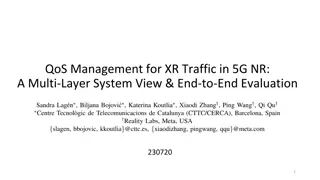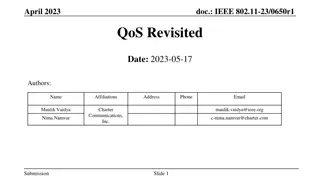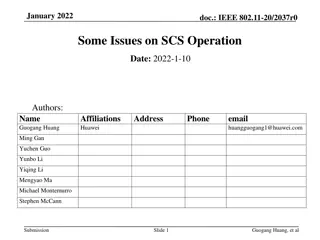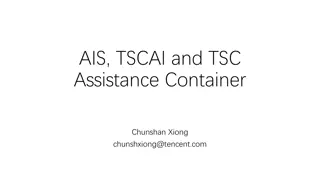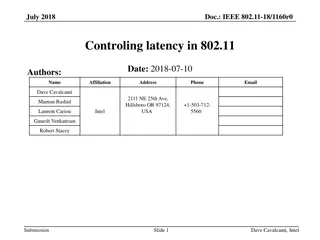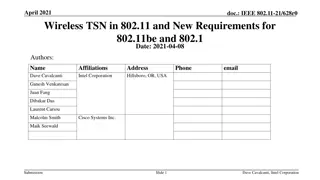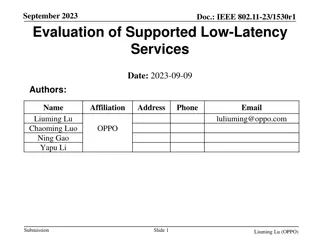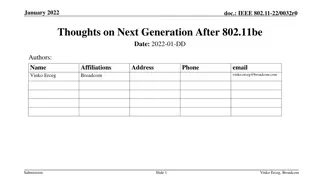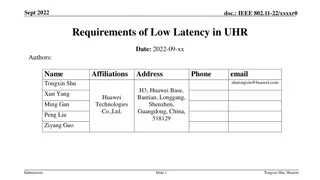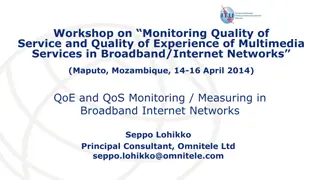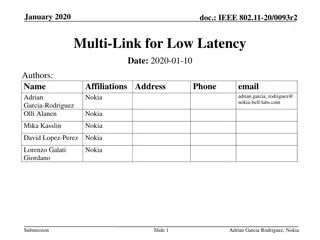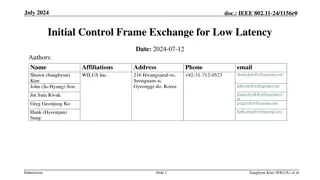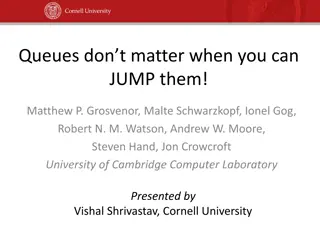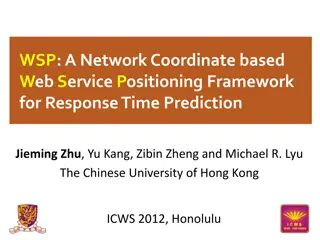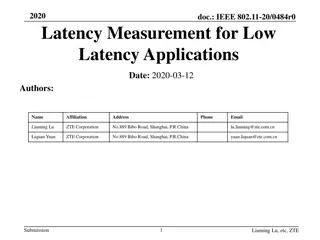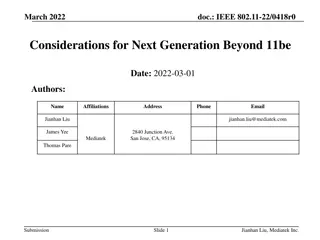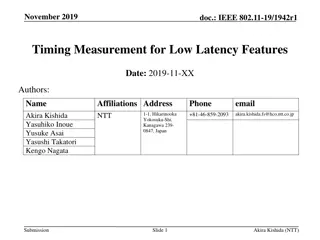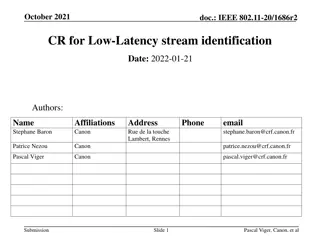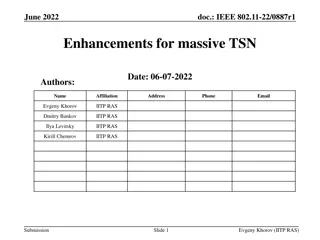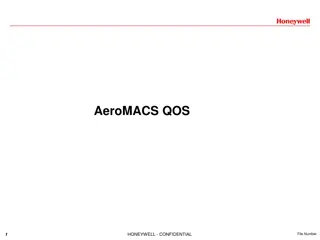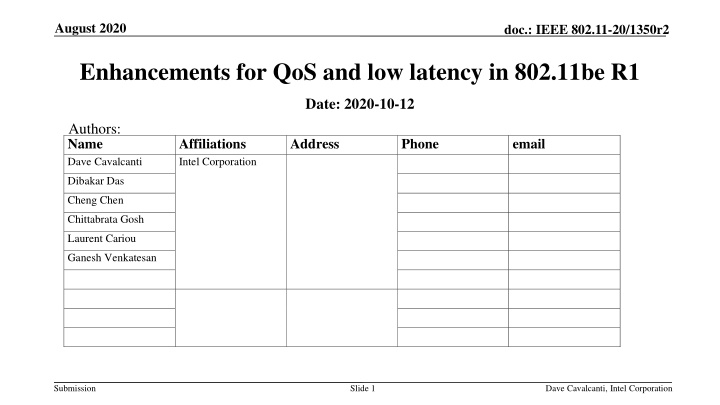
Enhancements for QoS Management in IEEE 802.11be Standard
Explore the proposal for enhancing Quality of Service (QoS) management in the IEEE 802.11be standard to address low latency needs for emerging applications like AR, VR, TSN, Cloud, Gaming, and IoT. The presentation outlines the current proposals and introduces a common signaling framework for specifying traffic characteristics and classification parameters to improve QoS negotiation.
Download Presentation

Please find below an Image/Link to download the presentation.
The content on the website is provided AS IS for your information and personal use only. It may not be sold, licensed, or shared on other websites without obtaining consent from the author. If you encounter any issues during the download, it is possible that the publisher has removed the file from their server.
You are allowed to download the files provided on this website for personal or commercial use, subject to the condition that they are used lawfully. All files are the property of their respective owners.
The content on the website is provided AS IS for your information and personal use only. It may not be sold, licensed, or shared on other websites without obtaining consent from the author.
E N D
Presentation Transcript
August 2020 doc.: IEEE 802.11-20/1350r2 Enhancements for QoS and low latency in 802.11be R1 Date: 2020-10-12 Authors: Name Dave Cavalcanti Affiliations Intel Corporation Address Phone email Dibakar Das Cheng Chen Chittabrata Gosh Laurent Cariou Ganesh Venkatesan Submission Slide 1 Dave Cavalcanti, Intel Corporation
August 2020 doc.: IEEE 802.11-20/1350r2 Introduction 802.11be is expected to provide low latency/QoS management solutions catering to new and upcoming applications like AR/VR/TSN/Cloud/Gaming/IoT. QoS negotiation allows an MLD to be aware of the QoS needs at an associated AP/non-AP STA MLD. This in turn allows an MLD to determine if it has enough resources to admit the stream and provide the expected QoS if an AP MLD, handle frames corresponding to each of the admitted streams as characterized and deliver the corresponding QoS. Main QoS negotiation in current spec is ADDTS Request/Response (TS Setup). The protocol was designed based on video and voice applications 15 years ago and is bit outdated. In this presentation therefore we propose enhancing the existing TS mechanism for 11be. The concepts in this contribution are aligned with Doc#1046r5, 418r4. Submission Slide 2 Dave Cavalcanti, Intel Corporation
August 2020 doc.: IEEE 802.11-20/1350r2 Recap: current related proposals in IEEE Some contributions such as 1355r5, 1046r7 propose to create specific SPs for low latency applications. Some contributions focus on the signaling from STA to improve UL scheduling: 1067r4 proposes signaling in A-Ctrl field for STA to inform AP about periodic traffic. 1006r3 proposes signaling in a Mgt frame for STA to inform AP about the min and max intervals between successive triggers. Also proposes establishment of scheduling session through exchange of those frames. Some contributions focus on signaling of traffic characteristics and classification: 908r1 proposes MLD-level TS setup. 418r4 proposes MLD-level QoS signaling of both layer-2 traffic and higher layer classification parameters. Submission Slide 3 Dave Cavalcanti, Intel Corporation
August 2020 doc.: IEEE 802.11-20/1350r2 Proposal overview We propose to have a common signaling framework to specify both the traffic characteristics and the traffic classification parameters. To meet R1 timeline, reuse ADDTS Req/Response framework with minor changes to capture below functionalities: The signaling could be at MLD level. Add some new parameters for next gen low latency services (TSN, AR/VR) similar to 5G URLLC. Allow AP to initiate QoS setup for achieving UL QoS by sending ADDTS Req; STA replies with ADDTS Response. Example scenario: an enterprise level videoconferencing session commences with subset of client STAs. Allow AP to modify assignment TS setup based on network conditions. Submission Slide 4 Dave Cavalcanti, Intel Corporation
August 2020 doc.: IEEE 802.11-20/1350r2 What do we need to signal ? Reuse TCLAS for packet classification. For describing traffic characteristics signal the following (in red are the new parameters): UP for the flow Inactivity Interval: lifetime for the flow. Max Service Interval Max MSDU size: Maximum size of MSDU Latency Bound: Maximum time required for successful delivery of the MSDU/A-MPDU (from MAC-SAP to MAC-SAP) Min Service Interval: requested minimal periodicity of service or min MSDU interarrival time Jitter: variation in latency (RTA) Burst Size: Max aggregate size MSDUs that arrive within a period Packet delivery ratio: Expected packet delivery ratio within the latency bound. More TSN Parameters (e.g., in R2). In addition, expand flow identifier from 8 values allowed by TSID to larger number on par with SCS (e.g., 255 values). Submission Slide 5 Dave Cavalcanti, Intel Corporation
August 2020 doc.: IEEE 802.11-20/1350r2 Signaling overview Define a new EHT-ADDTS Request/Response frame that has similar frame format as baseline (and hence, can mostly reuse the baseline TS setup) except that: EHT ADDTS Req/Response can be valid across the MLD. AP can send EHT ADDTS Request (there will be no EHT ADDTS-Reserve). The new IE (TSPEC-lite) can be used outside EHT-ADDTS Req/Response (e.g., with TWT). Submission Slide 6 Dave Cavalcanti, Intel Corporation
August 2020 doc.: IEEE 802.11-20/1350r2 Example of STA initiated QoS Setup STA initiates EHT ADDTS Req with a description of the QoS Traffic AP responds with EHT ADDTS Resp accepting the request QoS Traffic flows between the STA and the AP using the QoS setup for the flow(s) AP determines that the current QoS needs to be amended due to Network policy/conditions QoS flow policing decisions AP sends an EHT ADDTS Resp modifying the QoS Setup QoS Traffic flows between the STA and the AP with the amended QoS Setup Network Controller STA AP Network Policy/ Condition Traffic from/to the application with the setup Qos Network Policy/ condition/Policing Traffic from/to the application with modified QoS Submission Slide 7 Dave Cavalcanti, Intel Corporation
August 2020 doc.: IEEE 802.11-20/1350r2 Example of AP initiated QoS setup Network Controller STA AP QoS Traffic flows between the STA and the AP without any explicit QoS The application QoS may not be satisfied at this time. AP determines (out-of-scope) that the current QoS is not acceptable AP sends an EHT ADDTS Request to the STA STA sends an EHT ADDTS Resp accepting the proposed QoS Setup QoS Traffic flows between the STA and the AP with the QoS Setup Traffic from/to the application without any QoS setup Traffic monitoring Traffic from/to the application with QoS setup Submission Slide 8 Dave Cavalcanti, Intel Corporation
August 2020 doc.: IEEE 802.11-20/1350r2 Summary Proposed a unified framework for QoS signaling that requires minimal spec changes while satisfying critical low latency requirements. Submission Slide 9 Dave Cavalcanti, Intel Corporation
August 2020 doc.: IEEE 802.11-20/1350r2 SP#1 Do you support that 11be supports MLD-level TS setup ? Submission Slide 10 Dave Cavalcanti, Intel Corporation
August 2020 doc.: IEEE 802.11-20/1350r2 SP #2 Do you support that 11be defines a mechanism for an MLD to signal the following traffic characteristics/parameters to another MLD during TS setup: UP, Inactivity Interval, Max MSDU size, Latency Bound, Min Service Interval, Max Service Interval, Jitter, Burst Size, Packet delivery ratio? Submission Slide 11 Dave Cavalcanti, Intel Corporation
August 2020 doc.: IEEE 802.11-20/1350r2 SP #3 Do you support that 11be defines a mechanism for an AP to initiate TS setup with a non-AP STA by transmitting an ADDTS Request frame ? Submission Slide 12 Dave Cavalcanti, Intel Corporation
August 2020 doc.: IEEE 802.11-20/1350r2 BACKUP Submission Slide 13 Dave Cavalcanti, Intel Corporation
Month Year doc.: IEEE 802.11-20/1350r2 Signaling QoS characteristics via TSPEC Current TSPEC is not extensible for non-DMG but allowed for DMG. May be we can propose to extend it for EHT or propose an EHT TSPEC similar to DMG TSPEC (discuss). Below discussion assumes we will reuse TSPEC element. Fields present but may require new interpretation: Inactivity interval (profile lifetime) , Max MSDU size, Latency Bound, Burst Size, Min Service Interval Not present: Jitter, Packet delivery ratio (present in DMG Att but may have small size), Criticalilty, Tolerance to loss, Flow ID, Redundancy, whether TWT negotiation follows. ~30 bytes unused if we reuse TSPEC for existing parameters. To simplify signaling the fields in TSPEC that are not part of bullet 1 may be considered Reserved or repurposed to fit fields signaled in bullet 2. One of the Reserved bits in TS Info may be reused to signal this. Submission Slide 14 John Doe, Some Company

